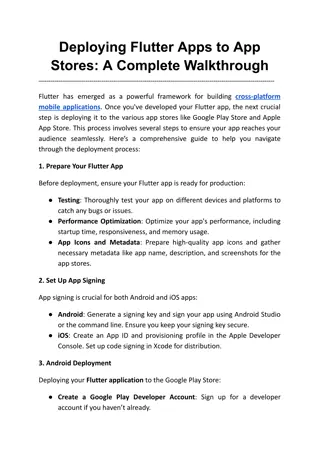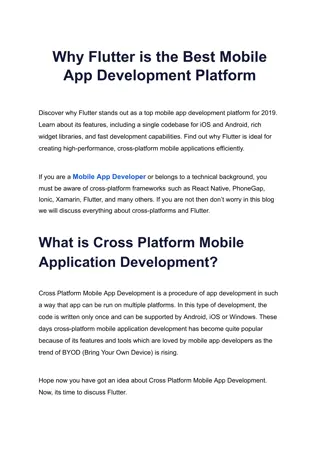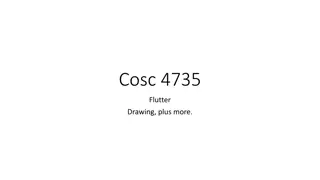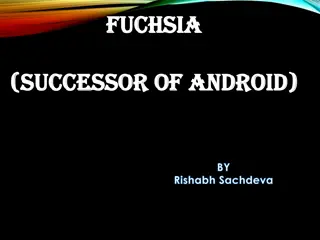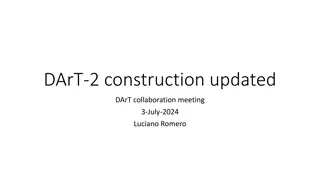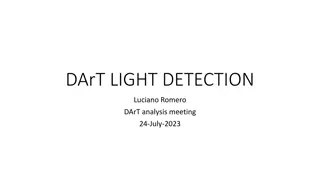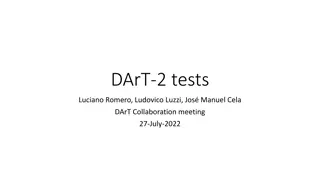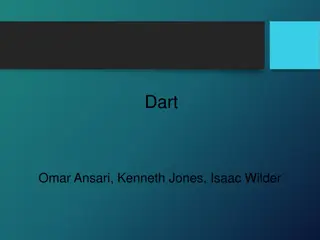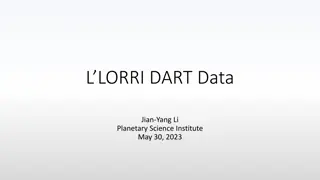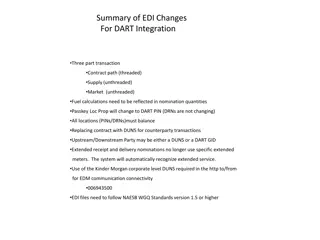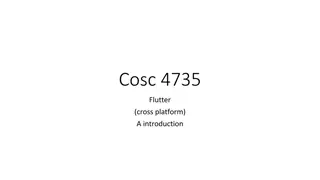Exploring Dart: A Comprehensive Overview of Flutter Programming
Dive into the world of Dart programming with this in-depth introduction to Flutter. Discover key features such as type safety, null safety, type inference, static and dynamic typing, explicit nullable declarations, and more. Uncover the basics of Dart syntax and learn how to create your first "Hello, World!" program in Dart.
Download Presentation

Please find below an Image/Link to download the presentation.
The content on the website is provided AS IS for your information and personal use only. It may not be sold, licensed, or shared on other websites without obtaining consent from the author. Download presentation by click this link. If you encounter any issues during the download, it is possible that the publisher has removed the file from their server.
E N D
Presentation Transcript
INTRODUCTION TO FLUTTER
DART PROGRAMMING LANGUAGE The Dart language is type safe - Snippet var staticType = "String"; it uses static type checking to ensure that a variable's value always matches the variable's static type Type Inference dynamic dynamicType = "String"; dynamicType = 10; Usage of dynamic type combined with runtime checks Dart has built-in sound null safety. The following code sample showcases several Dart language features, including libraries, async calls, nullable and non-nullable types, arrow syntax, generators, streams, and getters. To learn more about the language, check out the Dart language tour. 2
DART PROGRAMMING LANGUAGE The Dart language has type Inference is type safe it uses static type checking to ensure that a variable's value always matches the variable's static type Usage of dynamic type combined with runtime checks Dart has built-in sound null safety. 3
DART PROGRAMMING LANGUAGE HELLO WORLD void main() { print('Hello, World!'); } 4
DART PROGRAMMING LANGUAGE - VAR Dart has built-in sound null safety. var flybyObjects = ['Jupiter', 'Saturn', 'Uranus', 'Neptune']; var image = { 'tags': ['saturn'], 'url': '//path/to/saturn.jpg }; void main() { /// Types declaration var name = 'Voyager I'; var year = 1977; var antennaDiameter = 3.7; } 5
DART PROGRAMMING LANGUAGE EXPLICIT/NULLABLE is type safe /// Explicit not nullable declaration and assignment int declaredType; declaredType = 5; /// Explicit nullable declaration and check int? nullableVariable; if(nullableVariable == null) print("Nullable"); 6
DART PROGRAMMING LANGUAGE - STATIC/DYNAMIC it uses static type checking to ensure that a variable's value always matches the variable's static type /// Static type assignment var staticType = "String"; staticType = 10.toString(); /// Dynamic type assignment dynamic dynamicType = "String"; dynamicType = 10; 7
DART PROGRAMMING LANGUAGE FINAL and CONST Final is calculated only one time at runtime and then cannot be changed. Const is calculated at COMPILE TIME and cannot be assigned or changed at runtime. /// final and const variables final finalVar = DateTime.now(); const constVar = 3.14; 8
DART PROGRAMMING LANGUAGE STRING FORMAT /// String formatting print('String formatting:'); print(name + " " + year.toString() + " " + image['url'].toString()); print("$name $year ${image['url']}"); // Best practice for DART 9
DART PROGRAMMING LANGUAGE IF STATEMENT /// If Statement print("If statement:"); if (year >= 2001) { print('21st century'); } else if (year >= 1901) { print('20th century'); } 10
DART PROGRAMMING LANGUAGE SWITCH CASE /// Switch statement print("Switch statement:"); switch(year) { case(1977): print("Correct Year"); case(1978): print("Incorrect Year"); } 11
DART PROGRAMMING LANGUAGE FOREACH /// Foreach object for (final object in flybyObjects) { print(object); } 12
DART PROGRAMMING LANGUAGE FOR CYCLE /// For Cycle and increment operators for (int month = 1; month <= 3; month++) { print(month); } print("---"); for (int month = 1; month <= 3; ) { print(++month); // Count and print } 13
DART PROGRAMMING LANGUAGE WHILE LOOP /// While loop while (year < 1985) { year += 1; } 14
DART PROGRAMMING LANGUAGE WHILE LOOP /// Inline conditions var a = year ?? 0; // Not Null print(a); var b = year > 1982 ? 1 : -1; // Condition print(b); 15
DART PROGRAMMING LANGUAGE IMPORT and => import 'DartLanguageTypesAndFlow.dart ; void main () { /// '=>' operator flybyObjects.where((name) => name.contains('tu')).forEach(print); } 16
DART PROGRAMMING LANGUAGE CLASSES /// class class Spacecraft { String name; DateTime? launchDate; /// Read-only non-final property int? get launchYear => launchDate?.year; /// Constructor, with syntactic sugar for assignment to members. Spacecraft(this.name, this.launchDate) { /// Initialization code goes here. } } 17
DART PROGRAMMING LANGUAGE METHODS @override String toString() { return describe(); } /// Named constructor that forwards to the default one. Spacecraft.unlaunched(String name) : this(name, null); /// Method. String describe() { String tempString = ('Spacecraft: $name'); /// Type promotion doesn't work on getters. var launchDate = this.launchDate; if (launchDate != null) { int years = DateTime.now().difference(launchDate).inDays ~/ 365; return '$tempString Launched: $launchYear ($years years ago)'; } else { return '$tempString Unlaunched'; } } 18
DART PROGRAMMING LANGUAGE OBJECTS and LISTs /// objects var Apollo = Spacecraft("Apollo 1", null); print(Apollo.toString()); var Apollo2 = Spacecraft("Apollo 2", DateTime.now()); print(Apollo2.toString()); /// Lists /// --- var SpacecraftList = {Apollo, Apollo2, Spacecraft("Moon Lander", DateTime(1978))}; SpacecraftList.forEach((spacecraft){print(spacecraft.toString());}); 19
DART PROGRAMMING LANGUAGE ENUM /// Simple Enum enum PlanetType { terrestrial, ice, gas } /// Enum that enumerates the different planets in our solar system /// and some of their properties. enum Planet { mercury(planetType: PlanetType.terrestrial, moons: 0, hasRings: false), venus(planetType: PlanetType.terrestrial, moons: 0, hasRings: false), // uranus(planetType: PlanetType.ice, moons: 27, hasRings: true), neptune(planetType: PlanetType.ice, moons: 14, hasRings: true); /// A constant generating constructor const Planet( {required this.planetType, required this.moons, required this.hasRings}); /// All instance variables are final final PlanetType planetType; final int moons; final bool hasRings; /// Enhanced enums support getters and other methods bool get isGiant => planetType == PlanetType.gas || planetType == PlanetType.ice; } 20
DART PROGRAMMING LANGUAGE ENUM /// Simple Enum enum PlanetType { terrestrial, ice, gas } /// Enum that enumerates the different planets in our solar system /// and some of their properties. enum Planet { mercury(planetType: PlanetType.terrestrial, moons: 0, hasRings: false), venus(planetType: PlanetType.terrestrial, moons: 0, hasRings: false), // uranus(planetType: PlanetType.ice, moons: 27, hasRings: true), neptune(planetType: PlanetType.ice, moons: 14, hasRings: true); /// A constant generating constructor const Planet( {required this.planetType, required this.moons, required this.hasRings}); /// All instance variables are final final PlanetType planetType; final int moons; final bool hasRings; /// Enhanced enums support getters and other methods bool get isGiant => planetType == PlanetType.gas || planetType == PlanetType.ice; } 21
FLUTTER ARCHITECTURE Dart App Composes widgets into the desired UI. Implements business logic. Owned by app developer. Framework (source code) Provides higher-level API to build high-quality apps (for example, widgets, hit-testing, gesture detection, accessibility, text input). Composites the app's widget tree into a scene. Engine (source code) Responsible for rasterizing composited scenes. Provides low-level implementation of Flutter's core APIs (for example, graphics, text layout, Dart runtime). Exposes its functionality to the framework using the dart:ui API. Integrates with a specific platform using the Engine's Embedder API. Embedder (source code) Coordinates with the underlying operating system for access to services like rendering surfaces, accessibility, and input. Manages the event loop. Exposes platform-specific API to integrate the Embedder into apps. Runner Composes the pieces exposed by the platform-specific API of the Embedder into an app package runnable on the target platform. Part of app template generated by flutter create, owned by app developer. 22
FLUTTER HELLO WORLD! import 'package:flutter/material.dart'; void main() { runApp( const Center( child: Text( 'Hello, world!', textDirection: TextDirection.ltr, ), ), ); } 23
WIDGETs 24
WIDGET LIFECYCLE createState When Flutter is instructed to build a StatefulWidget, it immediately calls createState() Init State Called when this object is inserted into the tree. When inserting the render tree when invoked, this function is called only once in the life cycle. Here you can do some initialization, such as initialization State variables. setState The setState() method is called often from the Flutter framework itself and the developer. didChangeDependencies Called when a dependency of this [State] object changes. didUpdateWidget Called whenever the widget configuration changes. deactivate Called when this object is removed from the tree. Before dispose, we will call this function. dispose Called when this object is removed from the tree permanently. didChangeAppLifecycleState Called when the system puts the app in the background or returns the app to the foreground. 26 https://stackoverflow.com/questions/41479255/life-cycle-in-flutter
WIDGETS https://docs.flutter.dev/ui/widgets Text: The Text widget lets you create a run of styled text within your application. Row, Column: These flex widgets let you create flexible layouts in both the horizontal (Row) and vertical (Column) directions. The design of these objects is based on the web's flexbox layout model. Stack: Instead of being linearly oriented (either horizontally or vertically), a Stack widget lets you place widgets on top of each other in paint order. You can then use the Positionedwidget on children of a Stack to position them relative to the top, right, bottom, or left edge of the stack. Stacks are based on the web's absolute positioning layout model. Container: The Containerwidget lets you create a rectangular visual element. A container can be decorated with a BoxDecoration, such as a background, a border, or a shadow. A Containercan also have margins, padding, and constraints applied to its size. In addition, a Containercan be transformed in three-dimensional space using a matrix. 27
DART THROW and CATCH EXCEPTIONs throw FormatException('Expected at least 1 section ); try { } on Exception { } isThisThingWorking(); print( This thing is not working! ); 29
DART ASYNCHRONOUS PROGRAMMING (basic) Asynchronous programming A C B A B Synchronous programming ? S U1 U2 C S U1 U2 30
DART ASYNCHRONOUS PROGRAMMING (basic) Future<void> fetchUserOrder() { // Imagine that this function is fetching user info from another service or database. return Future.delayed(const Duration(seconds: 2), () => print('Large Latte')); } void main() { fetchUserOrder(); print('Fetching user order...'); } 31
DART ASYNCHRONOUS PROGRAMMING (basic) Future<String> createOrderMessage() async { var order = await fetchUserOrder(); return 'Your order is: $order ; } Future<String> fetchUserOrder() => Future.delayed( const Duration(seconds: 2), () => 'Large Latte', ); Future<void> main() async { print('Fetching user order... ); print(await createOrderMessage()); } 32
DART ASYNCHRONOUS PROGRAMMING (basic) // NOT WRITE LIKE THIS!!! String createOrderMessage() { var order = fetchUserOrder(); return 'Your order is: $order'; } Future<String> fetchUserOrder() => // Imagine that this function is more complex and slow. Future.delayed( const Duration(seconds: 2), () => 'Large Latte', ); void main() { print(createOrderMessage()); } 33
DART ASYNCHRONOUS PROGRAMMING (basic) import 'dart:math'; Future<String> createOrderMessage() async { var order = await fetchUserOrder(); return 'Your order is: $order'; } Future<void> getSugar() => // Imagine that this function is // more complex and slow. Future.delayed(Duration(seconds: Random().nextInt(5)), () => print('Sugar taken')); Future<String> fetchUserOrder() => // Imagine that this function is // more complex and slow. Future.delayed( Duration(seconds: Random().nextInt(5)), () => 'Large Latte',); Future<void> main() async { print('Fetching user order...'); getSugar(); print(await createOrderMessage()); } 34
FLUTTER THE MATERIAL CLASS class ElabFTWAppRead extends StatelessWidget { const ElabFTWAppRead({super.key}); // This widget is the root of your application. @override Widget build(BuildContext context) { return const Material( child: MainPage(title: 'elabFTW API Read Main Page'), ); } } 35
FLUTTER UI DESIGN and CREATION 1 -: Widget build(BuildContext context) { return Container( color: const Color(0xFF0BBD9D), width: 360, height: 54, padding: const EdgeInsets.only(left: 5, right: 5, top: 5, bottom: 5), child: Row(textDirection: TextDirection.ltr, children: [ ] ), ); } 3 2 1 3 -: const Expanded( child: Align( alignment: Alignment.centerRight, child: Icon( textDirection: TextDirection.ltr, color: Colors.white, Icons.more_horiz, ), ), ), ])); } } 2 -: Expanded( child: Align( alignment: Alignment.centerLeft, child: Text( title, textDirection: TextDirection.ltr, textAlign: TextAlign.center, style: const TextStyle( color: Colors.white, fontFamily: 'Roboto', fontSize: 14, ), ), ), ), 37
FLUTTER THE MATERIAL APP CLASS MaterialApp( theme: ThemeData( brightness: Brightness.dark, primaryColor: Colors.blueGrey ), home: Scaffold( appBar: AppBar( title: const Text('MaterialApp Theme ), ), ), ) 38
FLUTTER HTTP PACKAGE main.dart pubspec.yaml 41
FLUTTER HTTP PACKAGE args: chrome/webbrowsers --web-browser-flag "--disable-web-security" 42
FLUTTER API REQUESTs late Future<String> _responseStr; final String API_Auth_Token = $TOKEN; Future<List<Map<int, String>>> fetchExperiments() async { print("get!"); final response = await http.get( Uri.parse( "https://prp-electronic-lab.areasciencepark.it/api/v2/experiments"), headers: {"Authorization": API_Auth_Token}); print(response.statusCode.toString()); if (response.statusCode == 200) { List experimentsList = json.decode(response.body); experimentsList.forEach( (element) => print("${element['id']} : ${element['title']}")); return List<Map<int, String>>.from(experimentsList.map((element) => <int, String>{element['id']: element['title']} as Map<int, String>)); } else { // If the server did not return a 200 OK response, // then throw an exception. throw Exception('Failed to find experiments'); } } late Future<List<Map<int, String>>> futureExperiments; @override void initState() { super.initState(); futureExperiments = fetchExperiments(); } 43
FLUTTER FUTURE BUILDER child: FutureBuilder<List<Map<int, String>>>( future: futureExperiments, builder: (context, snapshot) { if (!snapshot.hasData) { return Center(child: CircularProgressIndicator()); } else { return Container( child: SizedBox( width: 200, height: 500, child: ListView.builder( itemCount: snapshot.data!.length, scrollDirection: Axis.vertical, itemBuilder: (BuildContext context, int index) { return GestureDetector( child: Text('${snapshot.data![index].keys}'), onTap: () => _showExperiment( snapshot.data![index].values.first), ); }))); } }), ), 44


